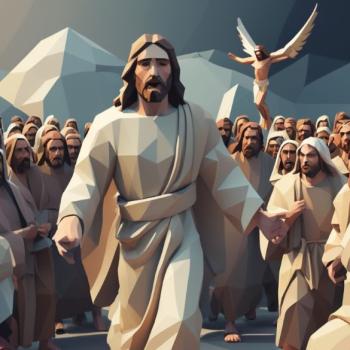Each Tuesday in Music Matters, Matthew Linder explores the intersections of music, culture, and faith.
In a recent article (“Worship and Identity: The Role of Beauty in the Church”) at Transpositions, I was struck by this assertion by Holly Ordway, chair of the Department of Apologetics and director of the MA in Cultural Apologetics at Houston Baptist University: “Certainly, all the money used to build a church and make it beautiful could be given to the poor instead—but that would not be feeding the poor in their complete hunger. Yes, we must care for the physical needs of the weak, the poor, the helpless, but we must also care for their hunger for beauty and meaning, for nourishment for the heart and soul.” Ordway’s statement seeks to identify the purpose of beauty in our lives, as more than a frivolous pursuit but something we deeply long for and need to experience on a daily basis. Without beauty, our souls would be as malnourished as our bodies would be apart from food.
This innate hunger for beauty stems from a God who is pure beauty, whether we know Him or not. This is the God David speaks of when he says he wants “to gaze upon the beauty of the Lord and to inquire in his temple” (Ps. 27:4). He’s the one Asaph describes: “Out of Zion, the perfection of beauty, God shines forth” (Ps. 50:2). This is the God whom the psalmist proclaims “made the heavens. Splendor and majesty are before him; strength and beauty are in his sanctuary” (Ps. 96:5–6). The one Isaiah said will feed His people with His beauty: “In that day the Lord of hosts will be a crown of glory, and a diadem of beauty, to the remnant of his people, and a spirit of justice to him who sits in judgment, and strength to those who turn back the battle at the gate” (Isa. 28:5–6).
And the beauty of Himself God has lavishly unveiled, from the Garden of Eden given for man’s enjoyment to the intricately detailed instructions for building the tabernacle and temple. Buildings constructed with colorful curtains, gold-laden objects, and incense-filled rooms. Though the tabernacle and temple were mere glimpses of the beauty that one day believers will experience as heaven descends upon the earth. Then we will see, touch, feel, taste, and hear the full beauty of God’s presence as He wipes away our every tear.
In the already/not yet world in which we currently reside, there contains another beauty that we all desperately need, the paradoxical beauty of the cross. The gore of our God on the cross, bleeding and suffering for our sins, is at times too much to bear because of the resplendent act that Jesus completed for us there. A macabre beauty wonderfully described in the tenor aria (“Erwäge, wie sein blutgefärbter Rücken”) from Johann Sebastian Bach’s “St. John Passion”:
Consider how his back so stained with bleeding
In every portion
Doth heaven imitate,
On which, when once the waves and waters
From our own Flood of sin have settled,
The world’s most lovely rainbow, arching,
As God’s own sign of blessing stands!
Powerful words on the grotesque beauty of Christ’s sufferings for our sins; but practically, how is beauty, specifically musical beauty, used to feed to the poor? Take for instance, Bill Strickland’s Manchester Bidwell Corporation which uses artistic beauty to inspire those who live in inner-city Pittsburgh. Strickland’s program has been so successful in feeding that hunger for beauty, the center now boasts a world-class jazz recording studio. Argentina’s El Sistema has impacted the poor in their country by involving youth in classical music performances, helping them transcend their dire situations by tapping into the beauty of music. In a small town in Paraguay, nestled next to a garbage dump, a man took what was once dirty, stinky junk and turned it into violins, cellos, drums, and numerous other instruments for children to play. In war-torn Afghanistan, where music was once banned, music is coming back in a number of surprising ways, from an Afghan youth orchestra playing Carnegie Hall in New York City to a music festival with metal and hip-hop acts.
Music is only one of the vehicles through which beauty is communicated to those who long for beauty in the midst of this chaotic world. While all these groups and individuals try to bring beauty to those who need it the most, it is, as Ordway describes: “[B]eauty that is intentionally oriented toward the living God, [that] is a gift that cannot be used up. It is a vision into the very nature of God, who is the source of all that is good. It can open up a window in the heart for the light of Christ to shine into.” This is the beauty we should cultivate in our churches and in culture through all of the arts. To feed the materially poor and the poor in spirit the beauty of the Bread of Heaven as He quenches thirst with living water and breathes new life into them. Beauty which will lead to worship of the triune God:















